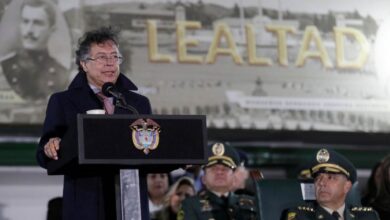Colombia: How Different Is The New Tax Reform From The Previous One?
Details have already been released that show the substantial difference between this project and the one presented in April, which was overthrown at the height of the National Strike .

The official presentation of the new tax reform before the Congress of the Republic will be on July 20, a day that will feature a day of massive protests throughout Colombia. Photo: YT-Presidency Colombia
LatiAmerican Post | Julián Gómez
Listen to this article
Leer en español: Colombia: Lo que trae de nuevo la reforma tributaria con respecto a la anterior
This week the unofficial presentation of the renewed tax reform was made in Colombia. The person in charge of breaking it down was President Iván Duque himself with a diverse audience among congressmen from various parties, unions, governors, businessmen, mayors and young people. From the outset, they want to show that the project has more support than the previous one, presented in April and that it led to the social outbreak of the National Strike, which threatens to reactivate.
The official presentation of the new tax reform before the Congress of the Republic will be on July 20, a day that will feature a day of massive protests throughout Colombia. However, the government of Iván Duque is urged that this tax reform comes to fruition to alleviate the fiscal gap generated by the pandemic.
“The message is in the background. What does this clear effort by the Solidarity Income, the PAEF, the support for youth employment and free tuition mean, added to the existing conditional cash transfer programs? It means, dear friends, that we are going to touch the lives of more than 10 million homes, "said Iván Duque, President of Colombia.
In terms of social investment, 731,000 Colombians who do not receive any kind of state aid will receive the Ingreso Solidario subsidy for the first time. Most of the collections leave the middle class alone and rely on companies to achieve the 15.2 trillion pesos projected in the next two years, which implies that this reform will not be structural and therefore in the medium term there will be more projects of tax reform. In addition, it raises state austerity as a pillar for collection.
“We will focus the program on small companies and we will include individuals with businesses that employ at least two people… The articles proposed by the Ministry of Finance will not touch the middle class… (we want to) shake hands with the most vulnerable, achieve fiscal stability and contribute to the economic growth of the country ”, affirmed José Manuel Restrepo, Minister of Finance.
Conoce los cuatro grandes módulos que trae el proyecto de Ley de #InversiónSocial, que en su conjunto buscan fortalecer el financiamiento del gasto social para reactivar la economía, reducir el gasto público y estimular la formalización tributaria https://t.co/IRElHuWRIQ pic.twitter.com/iBwI9MjXDj
— MinHacienda (@MinHacienda) July 14, 2021
Where does the 15.2 trillion pesos come from?
The money collected for the new tax reform is divided into 1.9 trillion in spending austerity, 2.7 trillion from the fight against tax evasion, 3.9 trillion with the reduction to 50% of the ICA (Industry and Commerce), 6, 7 billion with an increase in the income of legal entities.
What will the collection be spent on?
The cost of the new tax reform will be 8.7 trillion from the financing of the Solidarity Income in 2021 and 2022, 1.1 trillion in payroll subsidies to companies with less than 50 employees, 0.7 trillion in education projects such as enrollment zero and relief to students with debts in Icetex and 0.81 billion in employment program. The remaining amount will go to cover the fiscal gap caused by the pandemic.
It may interest you: What is happening in Colombia?
What are the differences with the previous reform?
-
The first change at a glance is the name. It is no longer the Law of Sustainable Solidarity, but a Social Investment Project.
- The second change is the amount of the collection. While the tax reform of José Manuel Restrepo seeks to raise 15.2 billion pesos , that of the former Minister of Finance, Alberto Carrasquilla, sought almost 23.4 billion pesos.
- This Tax Reform will leave VAT intact. The previous project sought to tax 43% of products with VAT. Even the previous project proposed to put VAT of 19% on public services for strata 4, 5 and 6, this time not.
- Individuals who earn more than 2.4 million pesos a month will no longer have to pay income tax as stated in the previous proposal.
- Companies will increase income tax from 30% to 35%. Companies in the financial sector must pay 38% income tax. These measures were not contemplated in the previous reform either.
- The new tax reform project will have a state austerity plan cutting expenses on travel expenses, vehicles and mobile telephony, among others.
- While the previous project contemplated putting income tax on pensions above 4.8 million, this new project will not do so.
- Another of the absences of the new reform is that of the wealth tax, which was contemplated by the previous one.
- The new document proposes a discount for companies of 50% of the ICA (Industry and Commerce Tax). The discount was 100%.
It may interest you: Tax reform: Blessing or curse for cinema in Colombia?
Thus, while the previous Tax Reform proposal intended that 86% of the collection was a product of VAT and income from natural persons, the new one expects to collect 73% from banks and companies. There is still the presentation of the document before the Congress of the Republic and its due socialization with the different sectors affected.




